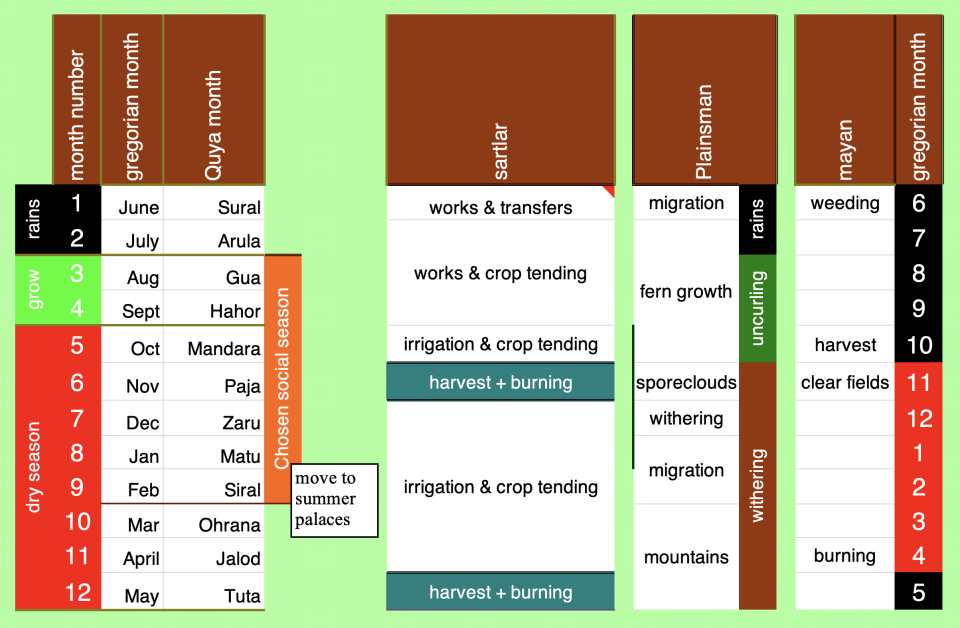Chapter: The Blood-Ring
Information relevant to the 4th chapter of The Masters
Information relevant to the 4th chapter of The Masters
for my new universals menu
The south-eastern depression of the Pillar of Heaven contains the Quyan Ladder that Carnelian and Osidian descend to the Yden
A child fathered by a God Emperor has its mother’s taint placed on the right and the left is left unscarred to indicate the untainted blood of the father. This reversal is a result of the belief that a God Emperor is possessed of a sinistral nature associated with the darker aspects of the Twin Gods.
I compiled this spreadsheet to keep track of events recurring every year.

This shows a composite of the calendars that I used throughout the writing of the Stone Dance. This covers not only the calendar used by the Chosen, but also how this interfaces with our own. The seasons of the Plainsmen are shown, as well as a comparison with the Mayan calendar that was what I used to give me an understanding of a tropical monsoon climates. Other information related to the seasons is included
The Chosen inherited their calendar from the Quyans. Like all calendars, that of the Quyans seeks to measure and describe the passage of time and of the seasons as accurately as possible. The drive for this is particularly important in an agrarian based civilization. This importance is reflected in the calendrical stones that are located in the Plain of Thrones and that are called the Stone Dance of the Chameleon
There are twelve months and three distinct seasons each characterized by a colour. Thus we have the Rains (black), the Growing Season (green), the Dry Season (red). The months in a season take that season’s colour. This arrangement is reflected in the colour of the 12 calendrical stones forming the innermost ring of the Stone Dance of the Chameleon, each one corresponding to a month
The Rains consist of the two black months—Sural and Arula—when the monsoon, coming from the sea in the far south-west, progressively breaks over the Guarded Land and Osrakum. The first day of Sural is generally the beginning of the new year, though the year can actually begin on an intercalated day (see below)
The Growing Season consists of the two green months Gua and Hahor—the period of the most intense vegetative growth
The long Dry Season consists of the eight red months—Mandara through to Tuta—when barely a drop of water falls from the skies
Quyan astronomers calculated their year to be 396.145 days long, and divided it into 12 lunar months, each of 33 days
Clearly, if they had left it at that, their calendar would quickly go out of sync with the observed year. To avoid this, they applied corrections, between the end and beginning of a year: these are termed intercalated days and are applied as follows. An extra day is added every 8 years—unless this falls at the end of a 48 year period, in which case two extra days are added—unless this falls at the end of a 1200 year cycle, in which case only a single day is added. Generally, the Apotheosis of a new God Emperor occurs at the beginning of a new year and can thus be held during an intercalating day
In the world of the Stone Dance, a day lasts 23.63 of our hours. Despite this, because of the extra number of days, the Stone Dance year is longer than ours. As a consequence the characters in the books are actually a little older than their stated ages might suggest
Underlying these timings is my original conceit that the Stone Dance is set on our own world, in the Late Cretaceous, when the Earth turned more quickly on its axis and when its orbit around the sun was slightly further out
The Chosen use a calendar devised by the Quyans. Too keep track of events, both those directly described in the text of the Stone Dance as well as those that occur in the background, I devised a number of chronologies; some are cyclic and annual, others are sequential
The Chosen do not, as we do, number years from a fixed starting point, rather they number them from the accession of a God Emperor. Thus Kumatuya 4 would be the fourth year in the reign of the God Emperor Kumatuya

This is an online companion for The Third God, the final book of seven of the Second Edition of the The Stone Dance of the Chameleon. Material relevant to this volume—drawn from my more than thirty notebooks—is laid out in the sidebar, ordered according to the chapters in the book.
The tag cloud below provides direct access to the SDC Companion
SPOILERS
accessing a page for a chapter you have not yet reached or use of the tag cloud may lead to spoilers
If you would like to hear from me and know what I am up to, please join my mailing list below
unless otherwise stated, all images are my own work